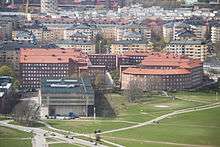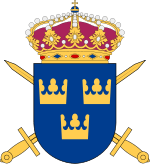Army Staff (Sweden)
| Army Staff | |
|---|---|
| Arméstaben (Ast) | |
|
Coat of arms of the Swedish Army Staff. | |
| Active | 1937–1994 |
| Country | Sweden |
| Allegiance | Krigsmakten/Swedish Armed Forces |
| Branch | Swedish Army |
| Type | Staff |
| Garrison/HQ | Stockholm |
Army Staff[1] (Swedish: Arméstaben, abbreviated Ast) was the staff of the Chief of the Swedish Army. It was established in 1937. The Army Staff's duties included, among other things to assist the Chief of the Army with leadership of the Army's mobilization, training, tactics, organization, equipment and personnel to the extent that such activity was not directly related to operational activities, which was handled by the Defence Staff.[2] In 1994 the Swedish Armed Forces Headquarters took over the Army Staff's duties.
History
1937–1963
As of 1 July 1937 the position as Chief of the Army (Chefen för armén) was established. The Chief of the Army would under the King in Council exercise the highest military leadership of the country defence. At his side, the Chief of the Army had an Army Staff to assist the Chief of the Army in his duties. Within the Army Staff the work was initially conducted in the following departments: Office with Cash Management, Organization Department, Education Department and Personnel Department.[3]
The inspection activities in the army were carried out by independent inspectorates, military branch inspectors and service branch inspectors with its own archiving, in the Military Archives of Sweden represented with own archives. Regarding the inspection activities for the Signal Corps and in the respect of the technical signal within the army in general, this was exercised by the staff of the Army Staff and the Chief of the Signal Corps.[3]
The instruction for the Chief of the Army (SFS 1937/669) was replaced in 1942 by the King in Council's instructions for the Army Command (Arméledningen). The term Army Command was used as the official term from 1942 to 1948, and partly later, for the Chief of the Army with the Army Staff. The Army Command consisted of the Chief of the Army and the Army Staff, the Recruiting and Replacement Office (Centrala värnpliktsbyrån), the Army Inspection, the Chief of the Home Guard along with the Home Guard Staff, the service branch inspectors, the Chief of the Army directly subordinate to personnel corps chiefs and the Royal Swedish Army Materiel Administration.[3]
Work within the Army Staff was conducted in an Organization Department, Equipment Department and a Personnel Department. There was also an office and a library as well as the Army Staff's stable (SFS 1942/863). Within the Army Inspection was now the military branch departments.[3]
New instructions for the Army Command came in 1949 (SFS 1949/600). The Army Inspectorate ceased and the military branch inspectors with departments was now incorporated in the Army Staff. The Army Staff was divided into two sections, Section 1 included the Organizational Department, Equipment Department and a Section Office and Section II included the Tactics Department, Education Department, the library and the Section Office. The Personnel Department was outside the sections. In the Personnel Department there was a Press and Adjutant Department. Additionally was the military branch departments. In 1959 the Section III was added, which included Personnel Department, Press Department and a Section Office.[3]
1964–1994
In June 1964, the Army Staff's new organization was established (TLA 1964:32).[2] The staff was according to the instruction organized in three sections, six military branch inspectors with eight military branch departments and a head's office. Section I handled the activities related to the army's peace and war organization, equipment and studies.[2] Section 2 was responsible for matters concerning the army's tactics, training and intelligence. Section 3 was responsible for the army personnel and press service. The military branch inspectors lead among other things, tests and some training. The military branch departments was the staff bodies of the military branch inspectors.[2]
In March 1976, the Army Staff had about 380 employees.[2] The Army Staff was in connection with the Swedish Armed Forces restructuring on 1 July 1994 merged with the Swedish Armed Forces Headquarters as the Army Command (Arméledningen).[4]
Location

The main part of the Army Staff was located in the building Generalitetshuset at Östermalmsgatan 87 and at seven other places in the Stockholm area.[2][5] Some parts of the Army Staff was from 1943 to 1981 located in the building Tre Vapen at Banérgatan 62-64 in Stockholm. In 1981 it moved to the building Bastionen at Lidingövägen 24 in Stockholm.[6]
Chief of the Army Staff
- 1936–1937 – Ernst af Klercker
- 1937–1940 – Helge Jung
- 1940–1942 – Folke Högberg
- 1942–1943 – Henry Tottie
- 1943–1946 – Hugo Gadd
- 1946–1948 – Ivar Backlund
- 1948–1953 – Viking Tamm
- 1953–1957 – Bert Carpelan
- 1957–1961 – Gustav Åkerman
- 1961–1963 – Arne Mohlin
- 1963–1966 – Stig Synnergren
- 1966–1968 – Ove Ljung
- 1968–1972 – Karl Eric Holm
- 1972–1974 – Lennart Ljung
- 1974–1979 – Gösta Hökmark
- 1979–1983 – Robert Lugn
- 1983–1988 – Krister Larsson
- 1988–1990 – Curt Sjöö
- 1990–1994 – Lennart Rönnberg
References
- ↑ Gullberg, Ingvar E. (1977). Svensk-engelsk fackordbok för näringsliv, förvaltning, undervisning och forskning [A Swedish-English dictionary of technical terms used in business, industry, administration, education and research] (in Swedish) (2nd ed.). Stockholm: Norstedt. p. 42. ISBN 91-1-775052-0. LIBRIS 8345587.
- 1 2 3 4 5 6 "Regeringens proposition 1977/78:63 om försvarsmaktens centrala ledning m. m." [Government Bill 1977/78:63 on the Armed Forces central command etc.] (in Swedish). Riksdag. 1 December 1977. Retrieved 23 April 2016.
- 1 2 3 4 5 Wallberg, Evabritta (1987-01-13). "Arméstaben > Förteckning" (in Swedish). National Archives of Sweden. Retrieved 22 April 2016.
- ↑ Försvarets traditioner i framtiden med översiktlig historik från 1500-talet (PDF) (in Swedish). Statens försvarshistoriska museer TradN. 2015. p. 11. ISBN 9789197859554. LIBRIS 17552963.
- ↑ Sköldenberg, Bengt, ed. (1970). Sveriges statskalender. 1970 (in Swedish). Uppsala: Fritzes offentliga publikationer. p. 110.
- ↑ "FLYGSTABEN på Ladugårdsgärde" (PDF). Flygvapennytt (in Swedish). Stockholm: Flygstaben (3). 1981. LIBRIS 8257600.
